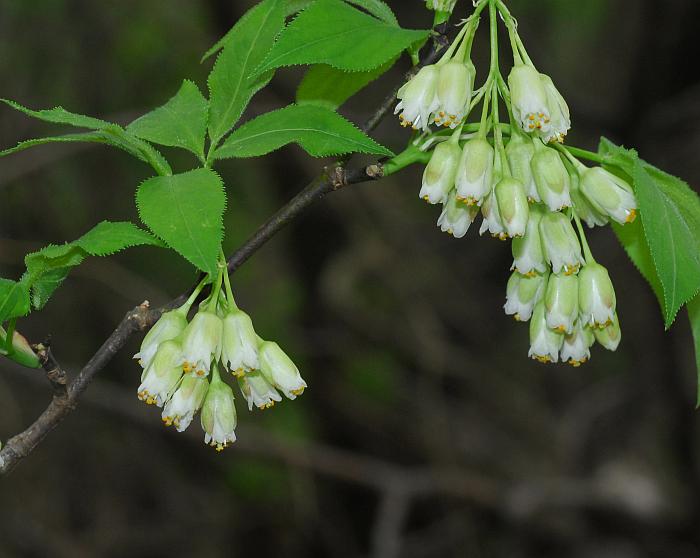Staphylea trifolia L.
American Bladdernut

Native
CC = 5
CW = 0
MOC = 87
© SRTurner
Staphylea trifolia L.American Bladdernut | |
 |
Native CC = 5 CW = 0 MOC = 87 |
© SRTurner |
|
Family - Staphyleaceae Habit - Shrubs or rarely small trees to 3 m tall, colonial by root suckers. Stems - Woody, multiple. Bark smooth or slightly furrowed with age, often appearing somewhat striped on branches, sometimes peeling in fine flakes with age. Twigs not angled, glabrous or minutely and inconspicuously hairy, greenish brown to reddish brown, the buds lateral, with several scales, ovate in outline, reddish brown, glabrous.
Leaves - Opposite, trifoliate, long-petiolate. Stipules membranous, linear, shed as the leaves develop. Leaf blades with the lateral leaflets short-stalked to nearly sessile, the middle leaflet longer-stalked. Leaflets 4-10 cm long, ovate to elliptic or oblong-obovate, short-tapered to a sharply pointed tip, narrowed or tapered at the base, the margins finely toothed, the upper surface glabrous at maturity or sparsely pubescent with shorter hairs, the undersurface moderately to densely pubescent with longer, crinkled, mostly multicellular hairs.
Inflorescence - Axillary or terminal on second year's branch growth, loose racemelike clusters 4-10 cm long, pendent, produced as the leaves develop or afterward.
Flowers - Perfect, hypogynous, actinomorphic. Calyx of 5 sepals, these fused at the base, 6-8 mm long, oblong-ovate to oblong-triangular, erect, green, glabrous. Corolla bell-shaped, of 5 free petals, these 8-10 mm long, obovate, erect with a usually spreading tip, white to greenish white. Stamens 5, small, free, the filaments attached at the base of a nectar disc, hairy below the midpoint, the anthers attached at the notch of the cordate base, exserted, yellow. Pistil 1 per flower, of 3 fused carpels. Ovary superior, 3 lobed, 3-locular, the placentation axile or appearing basal, with 4-12 ovules per locule. Styles 3, fused toward the base and also at the very tip, the stigmas forming a more or less disc-shaped mass.
Fruits - Strongly inflated pendant capsules, 3-5 cm long, obovoid, 3-lobed at maturity toward the tip, the lobes narrowed to sharply pointed tips, the walls thin and papery to somewhat leathery, brown, indehiscent or eventually dehiscent from the tip along the inner sutures of the lobes, usually persistent through the winter. Seeds 1-4 per locule, 5.5-6.0 cm long, ellipsoid to nearly globose, slightly flattened, the surface smooth, brown, somewhat shiny.
Flowering - April - May. Fruits persistent into winter. Habitat - Streambanks, bluff bases, wooded slopes, mesic upland forests in ravines, often on north- to east-facing slopes on calcareous substrates. Origin - Native to the U.S. Lookalikes - None when flowering. Other info. - This is a common shrub, found across Missouri and the eastern half of the continental U.S. The flowers don't last long but the fruits persist for some time. The plant is easily recognized from either. Vegetative ID is less straightforward, but is suggested by the long-petiolate, trifoliate leaves with finely toothed leaflets. The papery, inflated fruits contain only a few seeds, which somewhat resemble unpopped kernels of popcorn. Photographs taken in Columbia, MO., 4-15-04, and at Rock Bridge State Park, MO., 5-22-04 (DETenaglia); also near Labadie, Franklin County, MO, 4-8-2011 and 4-21-2015, Washington State Park, Washington County, MO, 4-11-2011 and 4-21-2015, Onondaga Cave State Park, Crawford County, MO, 9-5-2011, and Niangua Natural Area, Dallas County, MO, 4-22-2023 (SRTurner). |